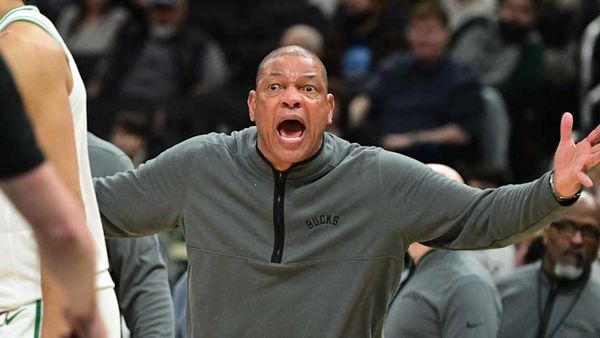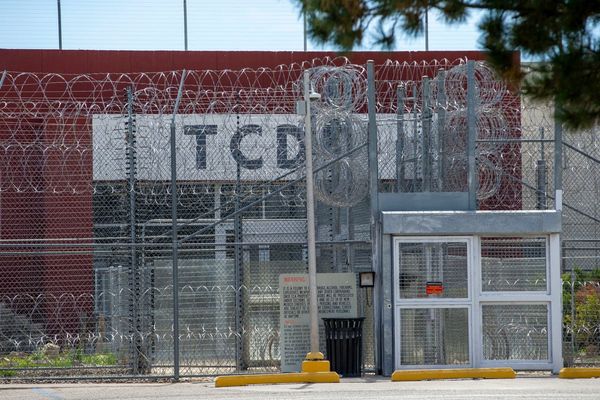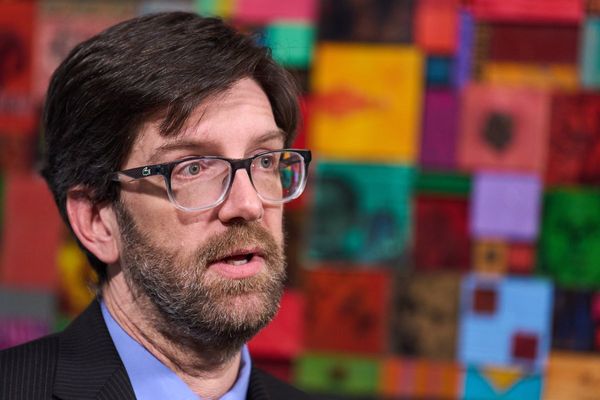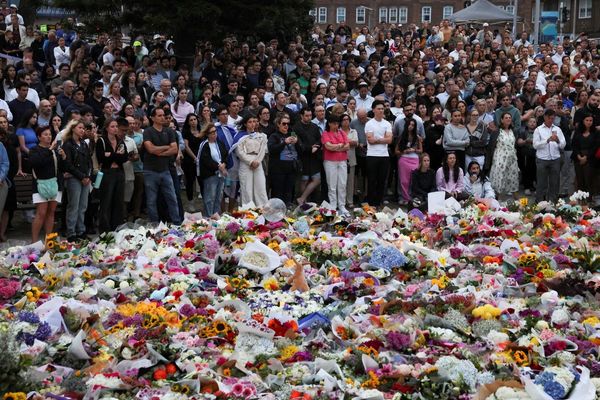
Closing summary
This live blog will be closing shortly. Thank you for reading the updates and commenting below the line.
You can keep up to date with the Guardian’s Africa coverage here.
Here is a summary from today’s blog:
Two protesters died from gunshot wounds and at least eight were injured in a town outside Nairobi on Wednesday as demonstrators marked one year since mass anti-government protests in Kenya. The demonstrations last year saw at least 60 people being killed and many more disappearing.
56 wounded people arrived at Kenyatta national hospital in Nairobi during protests, most of them with bullet wounds. A female police officer who had been attacked by protesters had also been brought in with head injuries.
Two Kenyan broadcaster were taken off air on Wednesday after authorities banned live broadcasts of anti-government demonstrations across the country. Communications authority of Kenya (CA) director general David Mugonyi said in a letter to the stations that the transmissions were illegal, with continued coverage risking “regulatory action”.
Katiba Institute, an organisation aimed at implementing Kenya’s constitution, has filed a petition against the police for blocking roads leading into and within Nairobi, branding the move “uunlawful”. There was a heavy police presence and the roads leading to parliament were barricaded with razor wire, as was president William Ruto’s statehouse office. During last year’s protests, demonstrators stormed parliament, burning part of the building as lawmakers fled.
The protests last year came as a response to a series of proposed tax increases which included hikes on sanitary towels, digital content, car ownership, and basics like oil and bread while many in the country were already grappling with a cost of living crisis.
56 people hospitalised in Nairobi during protests
An update to the number of people hospitalised in Nairobi during the protests today has raised the total to 56, most of them with bullet wounds, after participating in rallies on Wednesday to mark the one-year anniversary of deadly protests against a tax bill, a hospital source told Reuters.
It was not immediately clear who had shot the individuals, and Kenyan police spokesperson Muchiri Nyaga declined to comment on the injuries.
Some protesters clashed with police, and an official at the capital’s main Kenyatta national hospital (KNH) said the facility had received dozens of wounded people.
“As at 1600 hours, 56 patients had been admitted at KNH from the protest related injuries. Majority had rubber bullet injuries,” the hospital source told Reuters, adding that no deaths had been reported at KNH.
It was earlier reported that at least 10 people were hospitalised at the facility.
Updated
Legal challenge raised against police barricading of streets
Katiba Institute, an organisation aimed at implementing Kenya’s constitution, has filed a petition against the police for blocking roads leading into and within Nairobi, branding the move “uunlawful”.
The institute said in a statement:
Katiba Institute has today filed a constitutional petition at the High Court of Kenya in Nairobi challenging the unlawful actions of the Inspector General of Police and the Attorney-General for violating Kenyans’ constitutional rights to peaceful assembly and movement.
This urgent petition arises from the police’s decision today to barricade roads leading into and within Nairobi’s Central Business District (CBD) using barbed wire and police blockades. These actions, undertaken without notice, aim to prevent people from exercising their rights to demonstrate and picket as enshrined in Articles 37 and 39 of the Constitution.
The police were accused in the statement of undermining Kenya’s democratic gains.
Katiba Institute said it was seeking “urgent conservatory orders” to remove the barricades, while also seeking a permanent ban on unlawful limitation of the rights to protest and movement.
Updated
Smoke can be seen rising across the Nairobi skyline as fires rage across the city.
Bonfires that were lit by protesters along the Nairobi-Namanga Road in Kitengala have also been reported by Citizen TV Kenya.
Kitengala is a town in Kaijado county that sits south of the capial.
Updated
Citizen TV Kenya reports live rounds being used by police officers in Nairobi during Wednesday’s protests.
It comes as two protesters died from gunshot wounds in Matuu, around 100 kilometres (65 miles) from the capital.
Media outlets taken off air after ban on coverage
Kenyan broadcaster KTN was taken off air on Wednesday, it said on its Telegram social media channel after authorities banned live broadcasts of anti-government demonstrations across the country.
“KTN taken off-air following Communications Authority directive to halt live coverage of protests,” the broadcaster said, adding it was continuing to broadcast on social media platforms including YouTube, Facebook, and X.
The country’s NTV broadcaster was also pulled off air, a senior official at its parent company Nation Media Group said.
“We have been switched off from all the signal broadcasters, now we are only live on YouTube and the website,” the official told Reuters.
Communications authority of Kenya (CA) director general David Mugonyi said in a letter sent to the stations earlier on Wednesday that the transmissions were illegal, with continued coverage risking “regulatory action”.
Updated
Eugene Wamalwa, leader of the Democratic Action Party of Kenya, has attributed the media “blackout” from the Kenyan government to president William Ruto.
Wamalwa said in a post on X:
What is it William Ruto wants to hide from Kenyans by ordering a live coverage blackout?
Does he want to unleash the Military which we are aware is on standby at Nyayo stadium Nairobi on his fellow citizens,or the State sponsored goons who are already mobilized?
The party leader also described the use of force by police at the protests at “excessive”.
Here are some of the latest pictures coming through to us on the wires of the protests in Nairobi:
Two protesters die from gunshot wounds
Two protesters died from gunshot wounds and at least eight were injured in a town outside Nairobi on Wednesday as demonstrators marked one year since mass anti-government protests in Kenya, a hospital official told Agence France-Presse (AFP).
Julius Makau, administrator at a hospital in Matuu, around 100 kilometres (65 miles) from the capital, said:
One had abdominal gunshot wounds and died from excessive bleeding. We got an alert of another gunshot victim at another hospital but on arrival we found that the patient had already succumbed
It was not immediately clear how the victims sustained the gunshots wounds. The Nation newspaper reported police had opened fire.
Protesters were marching to mark a year since the peak of demonstrations over the economy that saw at least 60 people killed by security forces.
Makau said his hospital had received six people with gunshot wounds and three with other injuries, leading to one death.
One patient was in critical condition, while the rest were stable, he said.
In Nairobi, demonstrators engaged in running battles with police, who appeared to use primarily tear gas and rubber bullets as they sought to control the crowd.
Updated
My colleagues Carlos Mureithi and Caroline Kimeu reported on the initial protests outside the Kenyan parliament on this day last year.
The day saw chaotic scenes in which police started shooting after teargas and water cannon failed to disperse a crowd of thousands who had overwhelmed officers. Flames could be seen coming from inside the building.
You can read their original story here: Kenyan police open fire on protesters as crowd tries to storm parliament
Lawmakers leave parliament buildings
Lawmakers have left parliament buildings in Nairobi as protests intensify in the capital.
A large group of protesters is marching along Thika Road, a key highway in Nairobi, towards the capital as police retreat from the road.
Summary of the day so far
Several developments have come to light regarding the protests in Nairobi, Kenya, today.
At least 10 casualties have arrived at Kenyatta national hospital in Nairobi during protests to mark the first anniversary of the historic storming of parliament by protesters. The demonstrations last year saw at least 60 people being killed and many more disappearing.
All television and radio stations in Kenya have been asked to stop their coverage of the protests marking the first anniversary of last year’s finance bill protests. Communications authority of Kenya (CA) director general David Mugonyi said in a letter to the stations that the transmissions were illegal, with continued coverage risking “regulatory action”.
Most Kenyan media appears to be continuing with live coverage of today’s protests despite the order from the government to suspend such coverage. The Standard Group, which runs TV, radio and a newspaper, said in a statement on X that it was an attempted “news blackout” and that it would continue broadcasting.
Parliament and the president’s office in Nairobi were barricaded on Wednesday ahead of the protests. There was a heavy police presence and the roads leading to parliament were barricaded with razor wire, as was president William Ruto’s statehouse office. During last year’s protests, demonstrators stormed parliament, burning part of the building as lawmakers fled. Bodies lay in the streets, and medical workers and watchdogs said police had opened fire. The military was also deployed.
The protests last year came as a response to a series of proposed tax increases which included hikes on sanitary towels, digital content, car ownership, and basics like oil and bread while many in the country were already grappling with a cost of living crisis.
Updated
Media continue coverage despite government order
Most Kenyan media appears to be continuing with live coverage of today’s protests despite the order from the government to suspend such coverage.
The Standard Group, which runs TV, radio and a newspaper, said in a statement on X that it was an attempted “news blackout” and that it would continue broadcasting.
The group said:
We are consulting our lawyers to establish the legality of this order, which aims to plunge the country into a news blackout.
Meanwhile, we will continue broadcasting in the public interest until the legal position is confirmed.
It said it had information that the communications authority had “ordered signal carriers to deplatform any media house doing live broadcasts”.
The Standard Group said “similar threats” were made at the height of the 2024 protests.
Amnesty International condemned the ban, saying “silencing the press is not the solution”.
Updated
Pictures from Nairobi show teargas being used by police on protesters:
Agence France-Presse (AFP) reports signs of violence at the protests in the capital, with some protesters throwing rocks.
A man suspected of being a plain-clothed officer was manhandled by the crowd. Last year, unidentified police were seen shooting protesters during protests.
Alex Mukasa, a 28-year-old activist, said:
We are never violent, it’s the police and the hired goons they bring. When they start teargassing, they bring out the violence.
Local media on Wednesday published the names and photos of some of those who died during last year’s protests, the Associated Press (AP) reports.
The headline in a major newspaper, The Standard, read “A luta Continua,” which means “The struggle continues” in Portuguese and was the slogan of rebels during Mozambique’s struggle for independence from colonial rule.
Political analyst Herman Manyora called the protesters “heroes” who paid the ultimate price and should be remembered.
“The authorities should work with the demonstrators to ensure a good commemoration,” he said.
Manyora, however, warned that the protesters remain unhappy with the authorities because the “government has been intransigent and has hardened the resolve of the young people to keep fighting.”
During last year’s protests, president Willian Ruto dissolved the Cabinet that had been accused of incompetence and corruption but maintained most of his previous ministers in his new Cabinet despite concerns.
A finance bill proposing high taxes that had been passed by parliament was withdrawn, but later in the year, more taxes were introduced through legislative amendments.
The protests have now spread to other major Kenyan cities including Mombasa, Kisumu, Nakuru and Nyahururu, the Associated Press (AP) reports.
Citizen TV Kenya also reports protests taking place in Eldoret, Kakamega, Narok, Busia, Makueni, Nyeri, Laikipia, Nyandarua, Machakos, Homa Bay, and Kirinyaga counties.
Kenyan government orders halt to live broadcasts of protests
All television and radio stations in Kenya have been asked to stop their coverage of the protests marking the first anniversary of last year’s finance bill protests, Citizen TV Kenya reports.
Communications authority of Kenya (CA) director general David Mugonyi said in a letter to the stations that the transmissions were illegal, with continued coverage risking “regulatory action”.
The live coverage of the June 25th, 2025 demonstrations are contrary to Articles 33(2) and 34(1) of the Constitution of Kenya and Section 461 of the Kenya Information and Communications Act, 1998.
This is therefore to direct all television and radio stations to stop any live coverage of the demonstrations forthwith. Failure to abide by this directive will result in regulatory action as stipulated in the Kenya Information and Communications Act, 1998.
Pictures from Nairobi city centre show police firing water cannon at protesters:
The protests on 25 June 2024 saw police relying on teargas and water cannon to disperse the crowd of thousands of protesters.
Updated
To limit the movement of people into Nairobi’s city centre, police on Wednesday morning barricaded major roads a few kilometres to the central business district.
They also turned away buses and minibuses, popularly known as matatus, further away from the city centre.
10 injured during Nairobi protests
At least 10 casualties from protests have arrived at Kenyatta national hospital in Nairobi on Tuesday, Reuters and Citizen TV Kenya reports.
The local outlet said that at least four protesters are being treated at the hospital after having been shot by police.
It added that a female police officer who had been attacked by protesters had also been brought in with head injuries.
Updated
While street protests regarding the 2024 finance bill had become less common in the months since June last year, uproar has continued regarding issues such as police brutality and corruption.
A recent series of demonstrations were triggered in Kenya by the death of a teacher, Albert Ojwang, this month while he was being held in police custody after reportedly criticising a senior police official on social media.
Police originally said Ojwang had died “after hitting his head against a cell wall”, but an autopsy showed that his wounds – including a head injury, neck compression and several soft tissue injuries – were likely to have been the result of assault.
“These were injuries that were externally inflicted,” said Dr Bernard Midia, who led a team of pathologists for the postmortem examination.
Public anger erupted further as an officer shot a vendor, Boniface Kariuki, at close range during another round of protests last week.
In a joint statement on Tuesday, envoys from 12 countries including the US and the UK stated its support for “every Kenyan’s right to peaceful assembly and to express themselves” and urged all parties “to facilitate peaceful demonstrations and to refrain from violence”.
“The use of plain-clothed officers in unmarked vehicles erodes public trust,” the statement said.
Rights campaigners condemned the presence of unidentified police officers at protests last year.
The embassies said in their statement that they were troubled by the use of hired “goons” to disrupt peaceful demonstrations, after Reuters reporters saw groups of men beating protesters with sticks and whips last week.
— U.S. Embassy Nairobi (@USEmbassyKenya) June 24, 2025
Kenya’s foreign affairs ministry said in a statement late on Tuesday that any policing violations would be addressed through government institutions including parliament and the judiciary.
The counter-protesters have defended their actions, telling Reuters that they are not goons but rather patriots protecting property from looters.
Updated
My colleague and the Guardian’s East Africa correspondent in Kenya, Carlos Mureithi, has written an overview of the protests today in light of the first anniversary of parliament being stormed.
You can read Carlos’ article on the topic here: Fears of unrest as Kenyans mark first anniversary of storming of parliament
Parliament buildings and president's office barricaded
Parliament and the president’s office in Kenya’s capital, Nairobi, have been barricaded on Wednesday ahead of the protests, the Associated Press (AP) reports.
There was a heavy police presence and the roads leading to parliament were barricaded with razor wire, as was president William Ruto’s statehouse office.
During last year’s protests, demonstrators stormed parliament, burning part of the building as lawmakers fled. Bodies lay in the streets, and medical workers and watchdogs said police had opened fire. The military was also deployed.
Young Kenyans used social media to plan protests in remembrance of those who died last year. The government spokesperson, Isaac Mwaura, on Monday said there would be no protests, and that Wednesday was a “normal working day.”
But businesses in Nairobi on Wednesday remained closed and police limited the movement of vehicles into the central business district. Hundreds of Kenyans were already on the streets early in the morning, chanting anti-government slogans as police hurled teargas cannisters at some of the crowds.
Here are some of the pictures coming to us through the wires of the latest events unfolding in Nairobi:
Last year’s demonstrations, in which 60 people died and many more disappeared, were prompted by proposed tax increases.
The Kenyan government’s 2024 finance bill proposed a $2.7bn tax increase which included hikes on sanitary towels, digital content, car ownership, and basics like oil and bread, in a country already grappling with a particularly painful cost of living crisis.
Kenya’s cash-strapped government had said previously that the tax increases were necessary to service the huge public debt of 10tn shillings (£60bn), equal to roughly 70% of GDP.
Critics of the hikes began turning their attention to the International Monetary Fund (IMF), which was seen as the driving force behind president William Ruto’s since withdrawn plans.
Two weeks before the protests last year started, the Kenyan government and the IMF had a meeting where they agreed the government would increase taxes, reduce subsidies and cut government waste – in effect austerity measures – as conditions to access the IMF’s $3.9bn loan.
Ruto withdrew the bill a day after violent protests erupted around the country after its approval by parliament.
Welcome and opening summary
Hello and welcome to our coverage of the events unfolding in Nairobi, Kenya, today.
Thousands of protesters have taken to Kenya’s streets to mark a year since people stormed parliament at the peak of anti-government demonstrations, despite fears that they would be met by state-backed gangs and police violence.
Kenyans have planned to march across the country today to honour those who were killed during last year’s protests. The demonstrations last year saw at least 60 people being killed and many more disappearing.
Early on Wednesday, police blocked major roads leading into the capitals central business district, while government buildings were barricaded with razor wire.
The protests last year came as a response to a series of proposed tax increases which included hikes on sanitary towels, digital content, car ownership, and basics like oil and bread while many in the country were already grappling with a cost of living crisis.
President William Ruto scrapped the bill in response to the backlash and restructured his cabinet to include opposition figures. However, deep resentment against the president has continued to rise and public anger over the use of force by security agencies has not abated.







